Understanding The Features (And Mysteries) Of Your Garmin
Unboxing your new Garmin is exciting - and then, quickly, intimidating! So many features, so many metrics... here's the need-to-know.
Sometimes, the sheer volume of metrics on your device can feel overwhelming—especially if you use a Garmin, which feels like it now calculates pretty much everything other than your bone density. All these stats might leave you wondering, “But how do I feel, really?” Or, “Seriously, did that workout go well?”
After any given ride, your computer may tell you that the training load was heavy, but the recovery time you need is short. Your grit score is high, but your jump count was dismal. Your daily suggested workout sounds great, but doesn’t line up with the training plan you’ve been using.
To sift through all the numbers, we dug into the data and asked Garmin’s lead project manager in fitness, Joe Heikes, as well as Fast Talk Labs head coach and physiologist Ryan Kohler to help us understand our cycling computers (and our bodies).
First, let’s add some perspective: Cycling isn’t solely a numbers game. “I think before you consider any of these metrics, it’s important to ask the question, ‘What are you trying to gain from this workout or this training block?’” says Kohler. “It’s easy to get so overwhelmed by data that you forget what you’re actually training for. All this information is great, but only if we have a purpose for it. If we don’t have a purpose for it, or we’re not going to be able to really take some meaningful insights from it, then it’s not helpful.”
In recent years, Garmin has added a whole host of metrics that are calculated based on things like heart rate, power, altitude, temperature, and even GPS data to give you more feedback on every ride. Garmin’s cycling computers specifically focus on three primary data sets, using the standard power, heart rate, and cadence sensors, as well as bringing environmental factors into their calculations.
Here’s how each works, what to watch out for, and how you can use each one to guide your training.
Basic Garmin Metrics You Can Always Rely On
First and foremost, your Garmin cycling computer is a GPS computer that calculates your speed, duration and distance. Before getting into your jump count, remember that power, heart rate, and perceived exertion (which can’t be measured by a computer!) are the three big metrics when it comes to measuring the effectiveness of your training.
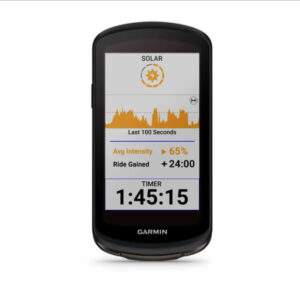
You may notice a few other power-based metrics popping up in Garmin Connect, depending on your power meter. It calculates your Normalised Power for each ride—the smoothed-out average power over the course of the ride, which takes into account things like wind, elevation change, and stoplights. It also helps you set your Functional Threshold Power (FTP), the highest power you can maintain for a full hour. The FTP is compared to your Normalised Power during a ride to give you the Intensity Factor of each ride. (Remember: You don’t always want a ride to be “intense.”)
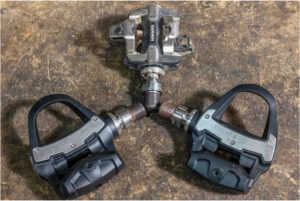
If you use Garmin’s pedal power meters, you’ll also get measurements of Torque Effectiveness to ensure that no energy is wasted, as well as Pedal Smoothness, which, as you may have guessed, lets you know how consistently you’re powering through each pedal stroke.
READ MORE Garmin’s Power Pedals – Welcome, Off-Roaders!
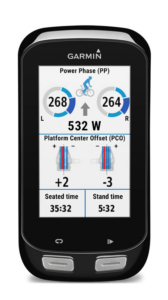
Note that some of these metrics won’t show up on the screen when you hit “end workout.” Sync your device to the Garmin Connect app to see all of your stats and trends.
Upgraded Garmin Metrics for More Details On Training
VO2 Max
VO2 max is essentially an indicator of overall fitness, giving you a heart rate-based calculation of the maximum volume of oxygen that your body can process when working hard on the bike. The estimate of your VO2 Max (to get a perfect, accurate measure, you’d need to be in a lab) should go up as you get fitter.
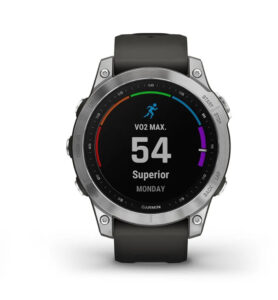
You can check this number in the Garmin Connect app, and it’ll update after every workout—though you should be focusing on trends over time, not slight variations to the number.
Excess Post Exercise Oxygen Consumption (EPOC) / Training Load
While your EPOC number doesn’t pop up as a major metric (and you won’t actually see it on your computer), it’s a good one to note because it plays an important role in calculating what Garmin dubs “Training Status” and recovery scores.
EPOC is the measure of oxygen consumed post-exercise, which helps put a number to just how much a single bout of exercise impacted you. This then helps Garmin determine your optimal recovery time and how your training overall is going.
The harder the workout, the higher the EPOC number. (Note that Garmin does not directly calculate the EPOC: It’s done based on a patented method from the company First Beat, which came up with a method of estimating EPOC from your in-activity heart rate.)
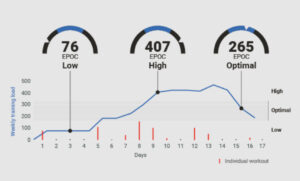
While again, you won’t necessarily see your EPOC number, it’s used to calculate your “Training Load,” and this is based on your EPOC numbers from the last seven days.
“The two main components that feed into your training status are, ‘how is your fitness trending?’ which looks at your VO2 max. And then, ‘what is your training load?’ which is the trend of your EPOC for the last several days,” says Heikes. “Basically, it’s the interaction of those two trends that give us the training status.”
Training status lets you know how productive your workouts are, based on whether your fitness is trending in the right direction. Most commonly, Garmin will tell you if a workout is productive or unproductive, but it might also let you know when you’re peaking, overreaching, or maintaining your fitness.
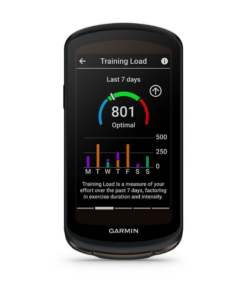
Before you panic that every workout is being labeled unproductive—a term that even Garmin is considering changing because, well, ouch—Heikes acknowledges the limitations of a cycling computer when calculating a workout’s effectiveness.
What is Garmin looking for when it’s telling you you’re unproductive? “Let’s say you’re increasing your training load, but we’re detecting that your fitness level is actually declining. That tells us that your training isn’t taking you in the right direction,” says Heikes.
Before you plan a rest week, ask yourself why you’re doing what you’re doing. “There can be times when the user is purposely piling on a higher training load, which will temporarily lower their fitness level, but will ultimately increase it,” Heikes adds. “That’s something we’re trying to improve so we don’t deem those situations unproductive. But in principle, we’re trying to help people stay steady with their training.”
Heikes adds that productivity isn’t tied to today’s workout specifically. If you feel like you crushed it in a ride, you absolutely did crush it in your ride. But if Garmin is warning you that the ride was unproductive, it simply means that the calculations it’s doing suggest that despite how good the ride felt, you might be heading in the wrong direction training-wise, possibly veering into overtraining territory if you’ve been putting in big rides every single day.
Recovery Time
This metric should pop up on your computer after saving your ride. While those familiar with using a Garmin watch for running and everyday life may be familiar with the Recovery Time metric, cyclists might be a bit mystified when they finish a ride and their cycling computer says they now need anywhere from six hours to four days of Recovery Time.
Garmin bases this metric mostly on your VO2 max, though some newer Garmin watches also incorporate in other daily training, stress levels calculated based on heart rate, and sleep score into the Recovery Time.
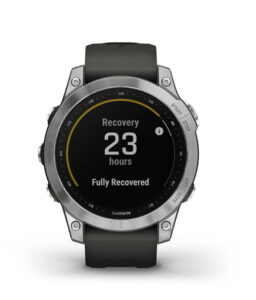
Don’t stress if Garmin suggests 48 hours of recovery and you have a group ride tomorrow. “When we say your recovery time is 20 hours, we don’t mean you have to sit on your ass for 20 hours,” says Heikes. “It’s meant to tell you how long it will be before you’re back at 100 percent.”
And as Kohler reminds us, rarely are we trying to get back to 100 percent before heading out on our next ride, especially during a training block. (Also, take note that while this Recovery time metric is rooted in data, the cycling computer also has some serious limitations compared to your watch, since it doesn’t know what else you’re doing or what you’ve already done.)
If you use a Garmin watch, you may notice other recovery metrics in lieu of or in addition to Recovery Time: Body Battery and Sleep Score. The Body Battery integrates heart rate variability (HRV), stress, and training to give you a score from 0 to 100 in terms of how much energy you theoretically have left in the tank. Sleep Score—which only works if you sleep wearing your watch—gives you a ranking from 0 to 100 regarding how well you slept, based on heart rate, heart rate variability, respiration rate, and body movement.
Garmin creates structured recommended workouts for you based on your recent/past workouts and training load, using your VO2 max as a guideline for setting power and heart rate targets. While these workouts might be useful for a new rider who doesn’t have a training plan, remember that your cycling computer doesn’t know about that strength-training workout you did last night.
Wearing a Garmin watch during other workouts—especially runs—and throughout the day gives Garmin Connect a better picture of your overall fitness. But because Garmin watches still can’t track anything other than heart rate during something like a strength training session, the data it’s working with might not be complete. So, the workout Garmin suggests for you may not be perfect, especially after leg day. That’s not to say you shouldn’t follow these suggested workouts, just consider what else you have going on to determine if it’s a good plan of attack.
Your computer can sense the temperature around you, as well as the elevation (altitude) where you’re riding. If you’re training for a hot or high race, this can be helpful as you prepare for it, since the computer takes into account how your power and heart rate are impacted by higher heat or higher altitudes, and lets you know if you’re adapting well to either.
These are great metrics to check if you’ve traveled to a training camp in a much hotter or higher climate, especially if you’re feeling stressed that the heat is slowing you down.
It’s worth noting that these metrics also have some limitations: Your cycling computer doesn’t know if you’re training low but living up at a higher altitude, or sleeping in an altitude tent. And while it senses temperature, sometimes it senses temperature a bit on the high side based on how the sun is hitting the screen, rather than “real feel” temperature, which can skew how well it believes you’re adapting to heat.
Extra Garmin Metrics for When You Hit the Trails
Mountain bike metrics only turn on when using your cycling computer on the Mountain Bike Activity Profile, but when you do that, here’s what you’ll find:
Jumps
Most new Garmin computers now count jumps, jump distance, jump speed, and hang time. For mountain bikers who love sending it, the Jump feature on Garmin can be a fun way to see how much time you’re spending in the air.
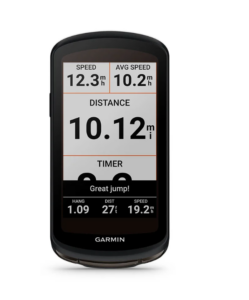
It takes these measurements via a built-in motion sensor. However, it’s not a perfect measuring tool for this, and can occasionally push newer riders into going a bit harder than they maybe are equipped for. (Also, note that Garmin alerts you when you’re jumping, so try not to look down at your computer when you’re mid-air!)
Grit
Your computer will give your ride a Grit score based on the difficulty of a ride using GPS, elevation, and other data collected by Garmin. This can be helpful in giving you a bit of context for how a ride really went.
If you were concerned your power was low on a twisty MTB ride, but then found that the Grit score for the ride was much higher than any ride you’ve done lately, it can help you understand why that ride felt so taxing. But it can also lead to feeling a little inadequate if your Grit score for a ride you found to be challenging was lower than you expected. In other words, don’t let it be the end all be all of how tough your ride felt.
Flow
Your flow score measures how smoothly you descend a trail on your mountain bike, which can help you better understand if your skills are improving on that downhill trail in your area.
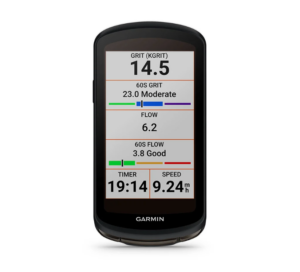
Like Grit, this score can feel encouraging when it’s good, but discouraging when it’s low. Kohler likes this score for riders who are keen downhillers or enduro enthusiasts, but warns that beginners shouldn’t try to “beat” their current score. “It can be dangerous to try to push yourself too hard as a beginner,” he says. “Focus on developing skills rather than just trying to best your time on a trail.”
What to Know About Using Multiple Garmin Devices
If you’re using a Garmin Vivoactive watch during strength training, know that it’s not chatting with your Garmin Edge cycling computer.
“With strength training, the only information we get is heart rate, so we won’t get a lot of information from that to apply to your on-bike training,” says Heikes. The company is working on making the watch smarter about strength, but for now, it won’t be able to relay the fact that it was leg day yesterday to your computer.
However, if you have two cycling computers—like an Edge 1030 and Edge 530—they will pass data between them via the Garmin Connect app, so the ride you did on your mountain bike with one Edge will be taken into account as you start pedalling on your gravel bike with the other computer the next day.
To Maximise the Accuracy of Your Data, Wear a Watch
“The big difference between cycling and running metrics is that runners are often wearing a watch all of the time, so we can gather a lot more data about the user,” Heikes notes. “When you have your watch on all the time, it’s possible to measure your stress all throughout the day and night, so the recovery time is more accurate. But you’re not wearing your cycling computer at work.”
For a more accurate training status or heart rate variability number, wearing a Garmin watch throughout the day (and when you sleep) will be the best way to ensure everything in your life is being accounted for, says Heikes.
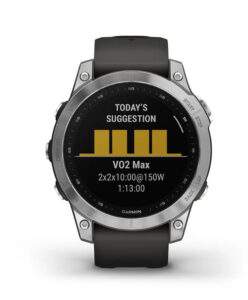
“Most of these metrics, like Recovery Time, will adapt as the device learns about you. When you first start using the computer, it makes a series of assumptions about you based on population averages. But your fitness level could be much higher, your resting heart rate could be much lower—all sorts of things of that nature can be different. The computer and watch start to learn that over time, and it makes the metrics more accurate to you. And the more you’re wearing a device, the better it can predict these metrics accurately. If you do three hours of yard work with the watch on, it will penalise your recovery time. Similarly, if you have low stress and a great night of sleep that’s logged, it will reward and lower your recovery time.”
What gets measured gets managed, and what gets measured consistently gets turned into more accurate metrics. “If possible, use the computer or watch every time you exercise,” says Heikes. “That’s the way we can get the training effect and the best estimate of your training load. That’s how we get the best VO2 max estimate. Using the computer every time you exercise gives you the best information.”
The Bottom Line: Key Garmin Metrics
Don’t try to tune into all the metrics, all the time: You’ll spend more time on data analysis than you do on pedalling! Pick a couple metrics that are important to you, like power measurements and heart rate reading, along with altitude acclimatisation if you’re heading to a mountaintop race.
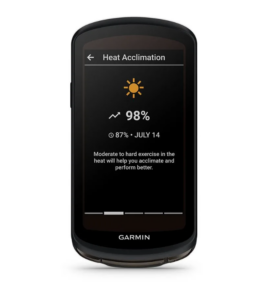
At the end of the day, it’s important to remember that your cycling computer is pretty darn smart, but it doesn’t live inside your head (though it may feel that way sometimes). If you find yourself constantly second-guessing how you feel—outsourcing if you’re achy or fatigued today instead of just tuning into your body—it might be time to hide the recovery score metric and focus on the basic data (distance, pace, etc.) instead.
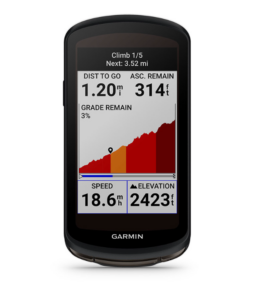
Also, if you’ve been seeing “unproductive” for your Training Status for a while, it might be time to check in with a coach. “First, I’d suggest hitting the brakes for a couple of days,” says Kohler. “Sometimes you may just need a bit more rest. But if that doesn’t change anything, I think you need to find a professional. Consulting with a coach to talk about your goals and come up with a basic training structure for you can be a great investment.”
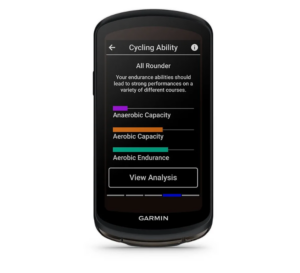
Finally, if part of the issue with your training is that it’s sporadic, Kohler notes that having a coach can also be a better way of adding accountability to your ride schedule compared to your computer yelling at you, without really knowing you.
READ MORE ON: garmin garmin edge heart rate HRV metrics power tech talk

